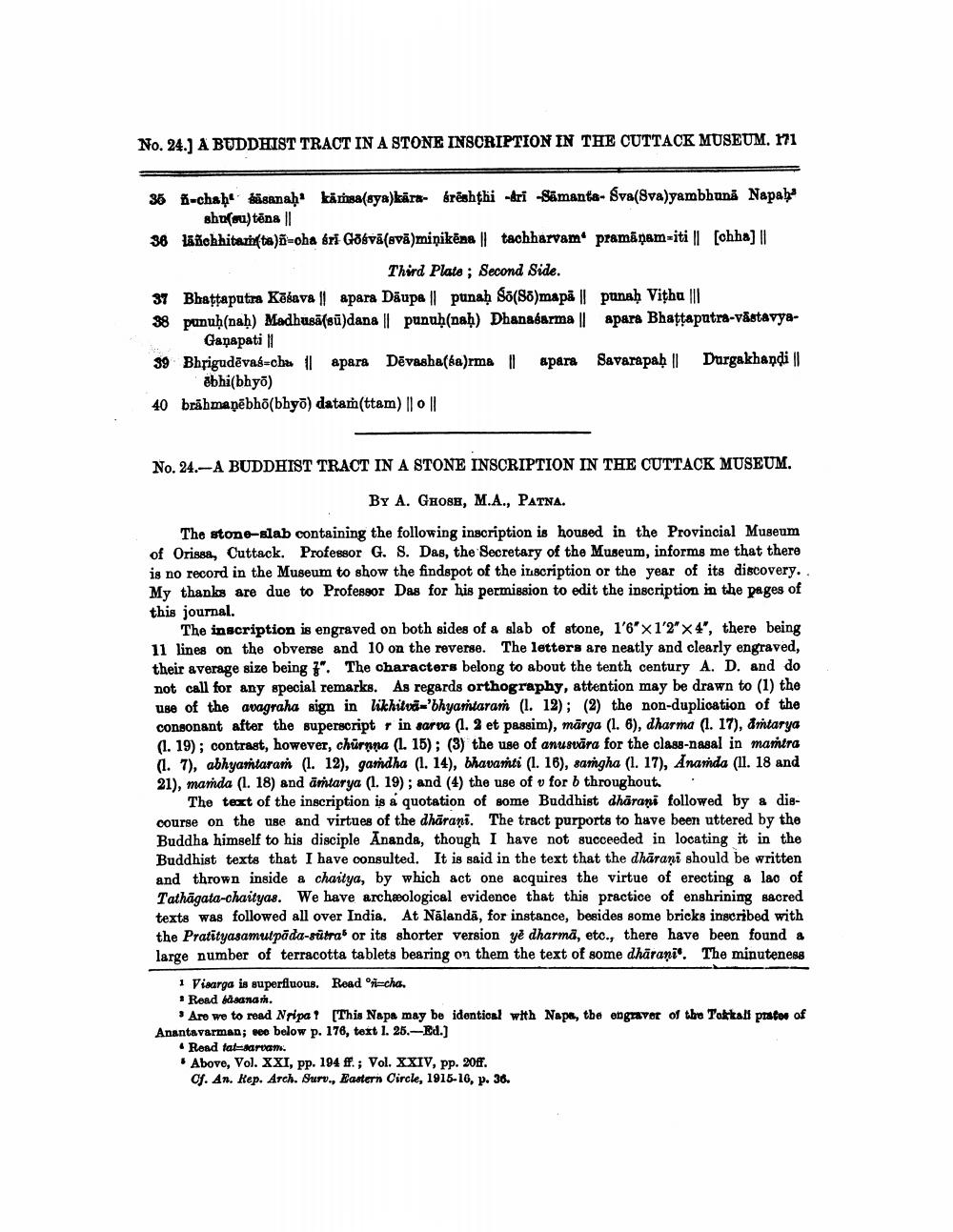________________
No. 24.) A BUDDHIST TRACT IN A STONE INSCRIPTION IN THE CUTTACK MUSEUM. 171
36 i-chah disanaḥ kärisa(sya)kärs- breshthi -dri Samanta-Sva(Sva)yambhună Napab
sho(a) tēna II 36 šehhitazid(ta) õ=oha sri Gosvä(svä)miņikēna || tachharvam. pramāņam-iti || [ohha) ||
Third Plate ; Second Side. 37 Bhattaputra Kosava || apara Dāupa || punaḥ Sõ(86)mapā || punaḥ Vithu ||| 88 punuḥ(naḥ) Madhusä(sū)dana || punuḥ(nah) Dhanabarma || apara Bhattapatra-vastavya
Ganapati 39 Bhrigudēvas=cha || apara Dēvasha(ta)rma apara Savarapaḥ || Durgakhandi ||
ebhi(bhyo) 40 brāhmaṇēbhõ(bhyo) dataṁ(ttam) || 0 ||
No. 24.- A BUDDHIST TRACT IN A STONE INSCRIPTION IN THE CUTTACK MUSEUM.
By A. GHOSH, M.A., PATNA. The stone-slab containing the following inscription is housed in the Provincial Museum of Orissa, Cuttack. Professor G. S. Das, the Secretary of the Museum, informs me that there is no record in the Museum to show the findspot of the inscription or the year of its discovery.. My thanks are due to Professor Das for his permission to edit the inscription in the pages of this journal.
The inscription is engraved on both sides of a slab of stone, 1'6" X 12" X 4", there being 11 lines on the obverse and 10 on the reverse. The letters are neatly and clearly engraved, their average size being 7". The characters belong to about the tenth century A. D. and do not call for any special remarks. As regards orthography, attention may be drawn to (1) the use of the avagraha sign in Whitvå-'bhyantaraṁ (1. 12); (2) the non-duplication of the consonant after the superscript r in sarva (1.2 et passim), mārga (1. 6), dharma (1. 17), antarya (1. 19); contrast, however, chürna (. 15); (3) the use of anusuára for the class-nasal in mantra a. 7), abhyamtaram (1. 12), gandha (1. 14), bhavanti (1. 16), sangha (1. 17), Ananda (Il. 18 and 21), mamda (1. 18) and amtarya (1. 19); and (4) the use of v for b throughout
The text of the inscription is a quotation of some Buddhist dhärani followed by a discourse on the use and virtues of the dharani. The tract purports to have been uttered by the Buddha himself to his disciple Ananda, though I have not succeeded in locating it in the Buddhist texts that I have consulted. It is said in the text that the dharani should be written and thrown inside a charitya, by which act one acquires the virtue of erecting a lao of Tathāgata-chaityas. We have archæological evidence that this practice of enshrining sacred texts was followed all over India. At Nālandā, for instance, besides some bricks ingcribed with the Pratityasamutpäda-sitra. or its shorter version ye dharma, etc., there have been found a large number of terracotta tablets bearing on them the text of some dharani. The minuteness
1 Visarga is superfluous. Read Ost-cha. . Read lisanan.
Are we to read Nripa? [This Napa may be identical with Nape, the engraver of the Toktall pratos of Anantavarman; see below p. 176, text 1. 25.-Ed.)
. Read tataram. . Above, Vol. XXI, pp. 194 ff.; Vol. XXIV, pp. 20fF.
Cf. An. Rep. Arch. Surv., Eastern Circle, 1915-16, p. 38.




